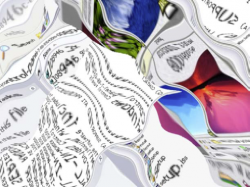|

April 2012-update.
DUL Radio is a piece of hardware/embedded software for physical interaction prototyping. The hardware has reached a final version 1.0, while the software is still under development. It does however run in a solid beta-version.
DUL Radio is wireless, it communicates sensor data via FM radio-transmission, hence the name.
It´s intended to provide a neat trade-off between complexity and efficiency, especially for interaction designers and digital artists working with sensor-based interaction.

DUL Radio is not a commercial product. Although it may be at some point. Eventually DUL Radio will be licensed as open source.
The hardware is available in limited quantities, being used internally for teaching audio and interaction design as well as in artistic projects. If you're interested to know more details, shoot us an email (you´ll find contact information at the bottom of this site).
DUL Radio hardware key features:
-All key components are integrated on one circuit-board: processor, terminals, power, wireless transmission circuit, antenna and even a 3D accelerometer.
-It´s small, 2.5x4.3x0.6 cm - Bear in mind, this is with all components.
-Atomization; It has centralized recognition of several communal independent data-streams: That is; the receiver can communicate with up to 4 DUL Radio´s simultaneously. With each DUL Radio having 2 terminals for analog sensor attachment and 1 3D accelerometer it makes a total of 8 sensor points and 4 accelerometers communicating from up to 4 different positions to one central receiver, simultaneously and synchronized.
DUL Radio software key features (to be expanded):
-Interfacing with several host applications, such as Max5 and Max6, Processing and Unity is possible. Basically anything that can read from a serial port can communicate with DUL Radio.
-Low level power handling that supports robust and very efficient power use, making the DUL Radio able to run for days, even with "realtime" continuously active analog sensors attached. This is thanks to the Alexandra Institute engineering guys who did a really neat job here!
-GUI-interface level to several low-level parameters, such as independent sample-rates and complex sleep/awake functions. These parameters are accessible in a so called Configuration Mode using a piece of custom software that can be downloaded from this site, (see "CONFIGURATION APP" further below).
PAPERS:
So far, two papers has been published about DUL Radio.
One presented as a work-in-progress-paper at the Tangible and Embedded Interaction Conference, TEI2011 , in Madeira, Jan. 2011 , in Madeira, Jan. 2011
Work in Progress Paper
And the final paper presented at the Tangible and Embedded Interaction Conference, TEI2012 , in Kingston, Canada, Feb. 2012 , in Kingston, Canada, Feb. 2012
Final Paper
OPERATING SYSTEMS, VERSIONING AND SETUP:
DUL Radio has been tested with and runs under Mac OSX 10.5.8, 10.6.8 and 10.7 as well as Windows7.
DRIVER:
OSX:
The DUL Radio receiver does not require a driver to run under OSX.
Windows:
The DUL Radio receiver requires a driver to run under windows7.
(NOTE: you´ll have to give win7 manual access to unpack and install the driver, due to some microsoft encryption mumbo jumbo).
Windows Driver 32bit
Windows Driver 64bit
JAVA:
Both communication with host-software and the custom Configuration App requires java-installation.
This is on both OSX and Windows.
OSX:
Since Java is part of the OSX-install, the DUL Radio will be readily available in the standard data transmission mode.
This goes also for Java5 in OSX 10.5.8. However, the Configuration App only supports java6 (and up).
Therefore make sure that the correct java version is installed and positioned correctly:
Go to Root/Applications/Utilities/Java Preferences:
In the General window-pane, make sure that Java SE 6 64bit or 32bit (depending on the mac you use), is at the top of the list.
Windows:
Since Java has to be installed manually, simply make sure to download and install the version your Windows system supports (32 or 64 bit).
DUL Radio and the SERIAL PORTS:
Several virtual serial ports are accessible via USB. Therefore several receivers (USB Stick´s) can be attached to one computer making it possible to receive data from X4 DUL Radio´s on the same computer. When doing so it is however very important to keep track of which receiver is communication with which serial port.
Likewise, it is possible to receive the data-streams from one DUL Radio in more than one host app simultaneously. The proper way to do so is to setup one of the host app´s to be the mother-host addressing the serial port and from there stream the data via a networking protocol to the other app(´s). This can be done using OSC/UDP or the like. Do not address the serial port from several host´s at the same time.
CONFIGURATION APP:
The Configuration App is still in an early state of development, but provide access to a vital part of the DUL Radio idea.
It handles the high level access to the parameter-based control of the processor. Thus making it possible to have fairly easy access to among other things; variable sample-rates, power handling and sleep/awake-functions.

A screenshot of the Configuration App.
An explanation of the parameters is available when positioning the mouse over the parameter names.
ConfigurationAppAlpha
A guide on how to configure DUL Radio in the Configuration App:
- The following only apply to OSX:
- -If you do not have a folder called "lock" in your root/private/var-folder,
- then please follows these instructions.
- -In Finder mode: Choose "Go to Folder…" in the "Go" menu, write: /var and click "Go".
- -If you do not have write permission to the var-folder, create a folder called "lock" on the desktop and copy it into the var-folder
- -Under all circumstances, make sure that you have read/write privileges to the lock-folder: cmd/i the folder and give "everyone" "Read & Write" Privilege under "Sharing & Permissions".
- The Configuration App:
- 0. Insert the USB stick into the computer.
- 1. Make sure no DUL Radio´s are turned on (while the ADC-ports are pointing upwards, press the left button to turn them off)
- 2. Open the Sensorboard.jar application in the ConfigurationAppAlpha-folder.
- 3. Reset the USB-stick (press the button furthest away from the computer).
- 4. Make sure the right serial-port is chosen.
- 5. Still with the ADC-ports pointing upwards; press both buttons on the DUL Radio, release the right one first.
- Both LED´s light up - if not, there is no power left on the battery.
- 6. Wait until both LED´s start to flash, Click "connect" in the Sensorboard.jar app.
- -If the LED´s do not start to flash, connection has failed, close the app and please go back to step 1.
- 7. You have now access to the configuration panel. When done configuring, click "Configure sensor board"
- 8. Press first right, then left button on DUL Radio.
- 9. Quit Sensorboard.jar app.
- 10. Make sure all DUL Radio´s are turned off, repeat step 2-9 for every DUL Radio you want to configure.
- NOTICE: The USB Stick´s LED lights continuously red when in configuration mode.
- When it receives data from the DUL Radio´s, it lights green in a pattern reflecting the data-transmission.
- When the DUL Radio´s are off, the USB Stick is in idle mode and flashes an orange light approx. every second.
HOST SOFTWARE (To be expanded):
Max5 & Max6:
To run the DUL Radio in Max, one vital element is neccesary;
A couple of java class files must be downloaded and placed here:
OSX: root/Applications/Max5(or Max6)/Cycling '74/java/classes
Windows: Program Files/Cycling '74/Max5(or Max6)/Cycling '74/java/classes
NOTE: There are two versions in the zipped file: a 32bit version and a 64bit version. Use the one that fits your system.
JavaInMaxforDULRadio
A couple of Max-patchers has been made, to provide easy access to monitoring DUL Radio data in Max. Make sure that the java class files in "JavaInMaxforDULRadio" are in the right place and that the USB Stick is attached to the computer, before starting up Max. In Max, open the "DUL-Radio4ch" max-patch, the other two patchers are sub-patches. Start the DUL Radio (press the right button with the analog ports pointing upwards), now accelerometer data should be visible in the monitor.
Max_Patchers
Processing:
DUL Radio can communicate with the Processing software through a library developed by Lasse Vestergaard.
Download the zip-file below, unzip and place the "DULRadio"-folder in the /Documents/Processing/libraries directory.
Open the /Documents/Processing/libraries/DULRadio/examples/Hello in Processing.
DULRadio_In_Processing
In relation to DUL Radio and Processing:
Fun with DUL Radio.
Our friend Paul Strohmeier having fun with a couple of DUL Radio´s, his wallet, a sponge and a Processing sound-library of sorts :-)
PIN-FORMAT ON ANALOG TERMINALS:

DEVELOPER DOCUMENTATION:
http://www.cs.au.dk/~jacand/Lunding/
CONTACT INFORMATION AND CREDITS:
DUL Radio was conceived in 2006 by Rasmus Lunding and developed in an early test version by Peter Friis and Anders Ebert. Since 2008 it has been re-developed, as part of DUL and the project "Byens digitale liv" in a partnership between Dept. of Aesthetics & Commincation (previoulsy: Dept. of Information & Media Studies) and the Alexandra Institute.
Aarhus University, Dept. of Aesthetics & Communcation:
This e-mail address is being protected from spambots. You need JavaScript enabled to view it
, project lead, mobile: +45 3068 0424
This e-mail address is being protected from spambots. You need JavaScript enabled to view it
, initiator and lead designer
This e-mail address is being protected from spambots. You need JavaScript enabled to view it
, project assistant and verification engineer
Aarhus University, the Alexandra Institute:
This e-mail address is being protected from spambots. You need JavaScript enabled to view it
, Alexandra project officer
This e-mail address is being protected from spambots. You need JavaScript enabled to view it
, research & innovation engineer, hardware
This e-mail address is being protected from spambots. You need JavaScript enabled to view it
, research & innovation specialist, software
Thanks goes to:
Bert Bongers @ Interactivation Lab, UTS, Sydney
Paul Strohmeier @ http://fkeel.blogspot.com
Davide Rocchesso @ UAV, Venice University
Tags: hardware | mobile | publication |













